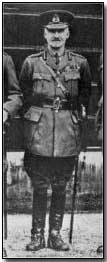Who's Who - Sir Henry Horne
 Sir Henry Sinclair Horne (1861-1929)
commanded the British First Army from September 1916 until the end of the
First World War.
Sir Henry Sinclair Horne (1861-1929)
commanded the British First Army from September 1916 until the end of the
First World War.
Horne received his commission into the Royal Artillery via the Royal Military Academy in 1880, and served with them during the South African War of 1899-1902. He was promoted Lieutenant-Colonel in 1905.
From 1912-14 Horne served as Inspector of Artillery. With the outbreak of war in August 1914 Horne, with the rank of Brigadier-General, was handed command of an artillery brigade attached to Douglas Haig's I Corps and despatched to France.
The following year brought the entirely straightforward, efficient Horne command of 2nd Division and a posting to Egypt and the Suez Canal, where he reported upon the preparedness of British defences.
Back in France once more Horne was given charge of XV Corps in January 1916. It played a prominent (and initially highly successful) role in the Battle of the Somme in July 1916, where his innovative approach to the 'creeping barrage' won him many plaudits (although XV Corps also played a role in the disastrous attempt on High Wood).
Horne demonstrated an ongoing enthusiasm for the development of technical and tactical improvements within artillery. Knighted in 1916 his next appointment brought him an army level command - First Army in September 1916 - which he retained until the armistice. Horne was the sole artillery officer of the war to be given command of a British field army.
Horne's army successes included Vimy Ridge in April 1917, at Arras on 28 March 1918 and during actions fought on the British Expeditionary Force's (BEF) left flank during the summer of 1918.
In 1919 Horne was appointed Eastern Commander in Britain. Parliament awarded him a grant of £30,000 and he was created Baron of Stirkoke.
He died in 1929.
An Armlet was a cloth band worn around the arm to identify a particular duty or function.
- Did you know?
